Harebell
The delicate, nodding blue bells of Harebells are one of the prettiest additions to our hedgerows, grasslands, hillsides, sand dunes and cliffs. Flowering between July and September, Harebells grow on dry, mostly undisturbed, ground, but are tolerant of all kinds of habitats. It is regularly visited by bumblebees and Honey Bees, providing an autumnal source of nectar for these insects. In Scotland, this is often the plant referred to as 'bluebell'.
Like many of our native plants, Harebells are an excellent source of nectar and pollen for all kinds of insects including bumblebees and butterflies. To encourage wildlife into your garden, try planting native flower species in your borders to provide a 'nectar-cafe'. To find out more about wildlife-friendly gardening, visit our Wild About Gardens website: a joint initiative with the RHS, there's plenty of facts and tips to get you started.
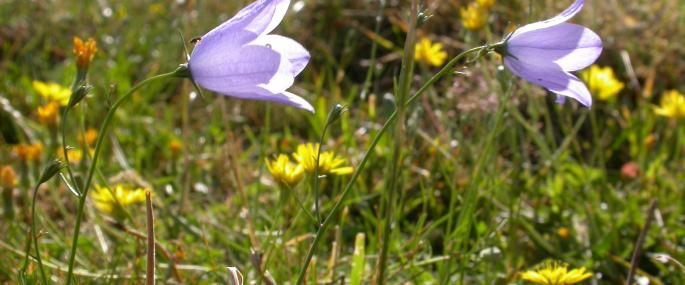
Ribwort Plantain
In contrast to the long flower spikes of Greater Plantain, the short, oval flower heads of Ribwort Plantain appear as if balanced on the top of their thin, wiry stems. Ribwort Plantain is a plant of grasslands, field edges and cultivated ground and tracks, and regularly pops up in lawns as a 'weed'. It flowers between April and October, but its seedheads remain for most of the winter providing food for Goldfinches and other seed-eating birds.
Many of our so-called 'weeds' are beneficial to wildlife, providing food for nectar-loving insects and shelter for minibeasts. Try leaving wilder areas in your garden, such as patches of Ribwort Plantain and Red Clover in your lawn and Stinging Nettles near the compost heap, and see who comes to visit... To find out more about wildlife-friendly gardening, visit our Wild About Gardens website: a joint initiative with the RHS, there's plenty of facts and tips to get you started.
Toadflax
Common Toadflax is a common plant of waste grounds, grasslands, roadside verges and hedgerows. Its orange and yellow flowers appear in June and can be seen well into November; they look like the flowers of snapdragons (familiar garden plants), and are often densely packed. These flowers give the plant its other common name of 'Butter and Eggs'.
Like many of our native plants, Common Toadflax is an excellent source of nectar and pollen for all kinds of insects including bumblebees and butterflies. To encourage wildlife into your garden, try planting native flower species in your borders to provide a 'nectar-cafe'. To find out more about wildlife-friendly gardening, visit our Wild About Gardens website: a joint initiative with the RHS, there's plenty of facts and tips to get you started.
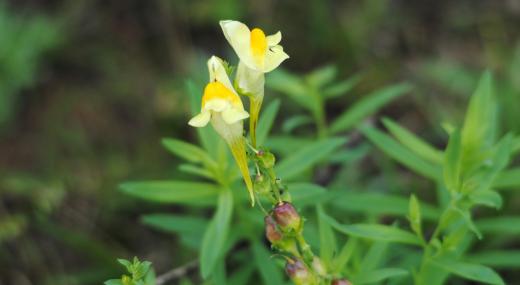
Water Figwort
Water Figwort is a common plant of riverbanks, pond margins, damp meadows and wet woodlands. Its maroon flowers appear from June to September, provide nectar for bumblebees and are pollinated by the Common Wasp.
Human activity, including the drainage of land for agriculture and development, has resulted in the disappearance of many of the UK's wetlands. The Wildlife Trusts are working closely with planners, developers and farmers to ensure our wetlands are protected. You can help too: add native plants and flowers, such as Water Figwort, to a wildlife-friendly pond and its margins, and provide shelter for amphibians and nectar for insects. In partnership with the RHS, The Wildlife Trusts' Wild About Gardens initiative can help you plan your wildlife garden.
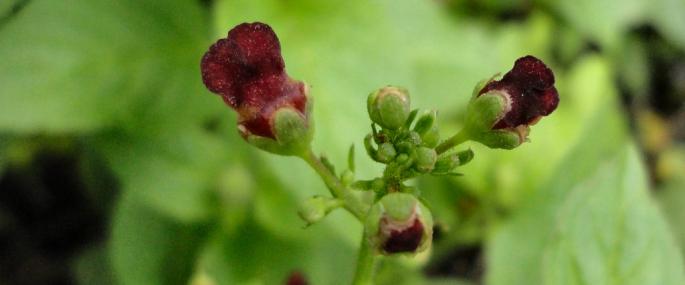
Great Mullein
The yellow, candle-like flower spikes of Great Mullein can reach up to two metres in height, making this an impressive plant of dry and grassy ground including gardens, waste ground and roadside verges. It is a biennial, spending its first year as a rosette of furry leaves and producing its flowers in its second year between June and August.
Like many of our native plants, Great Mullein is an excellent source of nectar and pollen for all kinds of insects including bumblebees and butterflies. To encourage wildlife into your garden, try planting native flower species in your borders to provide a 'nectar-cafe'. To find out more about wildlife-friendly gardening, visit our Wild About Gardens website: a joint initiative with the RHS, there's plenty of facts and tips to get you started.

Bittersweet
Despite being a member of the nightshade family, Bittersweet (also known as 'Woody Nightshade') is one of the less toxic plants in this group. Found in hedgerows, gardens and even on shingle beaches, its purple flowers appear from May to September and are followed by clusters of bright red, poisonous berries.
Despite its poisonous nature, Bittersweet is still a useful plant for wildlife with certain species being unaffected by its toxins. The Wildlife Trusts manage many nature reserves for the benefit of all kinds of wildlife, including many different species of plants. But these precious sites are under threat from development, intensive agricultural practices and climate change. You can help by supporting your local Trust and becoming a member; you'll find out about exciting wildlife happenings, events on your doorstep and volunteering opportunities, and be helping local wildlife along the way.
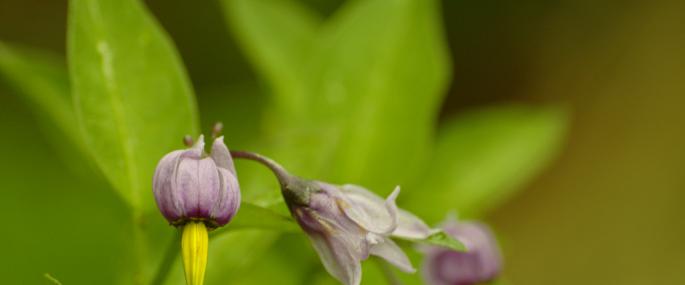
Deadly Nightshade
The poisonous nature of Deadly Nightshade is famous: its shiny black berries are perhaps a temptation to children, but fatal in even small doses. Found mainly on chalky and limestone soils, particularly on recently disturbed ground, this bushy perennial has bell-shaped flowers that appear from June to August.
Despite its poisonous nature, especially for humans and some mammals, Deadly Nightshade is still a useful plant for wildlife with certain species being unaffected by its toxins. The Wildlife Trusts manage many nature reserves for the benefit of all kinds of wildlife, including many different species of plants. But these precious sites are under threat from development, intensive agricultural practices and climate change. You can help by supporting your local Trust and becoming a member; you'll find out about exciting wildlife happenings, events on your doorstep and volunteering opportunities, and be helping local wildlife along the way.
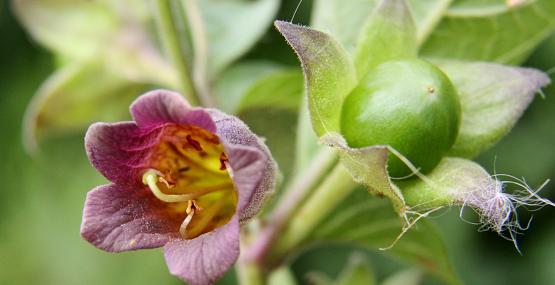
Hedge Bindweed
Climbing and twisting through hedgerows, woodlands, ditches and riverbanks, the white flowers of Hedge Bindweed are a familiar sight for many of us. Twining itself around other plants to assist its progress, this aggressive plant is often considered to be a weed in gardens, although it can provide excellent cover for fences and derelict buildings in towns and waste grounds. It flowers between June and September but the twisting stems can be seen in spring.
Although they sometimes don't look especially wildlife-friendly, our roadside verges and waste grounds can provide valuable habitats for all kinds of plants and animals. The Wildlife Trusts get involved in different projects to help make these places as beneficial for wildlife as possible. We have a vision of a 'Living Landscape': a network of habitats and wildlife corridors across town and country, which are good for both wildlife and people. You can support this greener vision for the future by joining your local Wildlife Trust.

Field Bindweed
Creeping through waste and cultivated ground, the white or pink-striped flowers of Field Bindweed are a familiar sight for many of us. Twisting around other plants to assist its progress, this aggressive plant is often considered to be a weed in gardens. It flowers between June and September.
Although they sometimes don't look especially wildlife-friendly, our roadside verges and waste grounds can provide valuable habitats for all kinds of plants and animals. The Wildlife Trusts get involved in different projects to help make these places as beneficial for wildlife as possible. We have a vision of a 'Living Landscape': a network of habitats and wildlife corridors across town and country, which are good for both wildlife and people. You can support this greener vision for the future by joining your local Wildlife Trust.

Viper's-bugloss
Mainly found on sandy and chalk soils, Viper's-bugloss is a hairy plant with dense spikes of bright blue, funnel-shaped flowers. Found on chalk grassland, sand dunes, cliffs and disturbed ground, it is in bloom from May to September. It provides food for a range of insects including Buff-tailed and Red-tailed Bumblebees, Large Skipper and Painted Lady Butterflies, Honey Bees and Red Mason Bees.
The Wildlife Trusts manage many grassland and coastal habitats for the benefit of all kinds of wildlife. Careful grazing with traditional breeds, hay-cutting at the right time and scrub clearance are just some of the ways these fragile habitats are kept in good condition - supporting wildflowers like Viper's-bugloss and, in turn, invertebrates and the larger animals that prey on them. By volunteering for your local Trust you can help too, and you'll make new friends and learn new skills along the way.